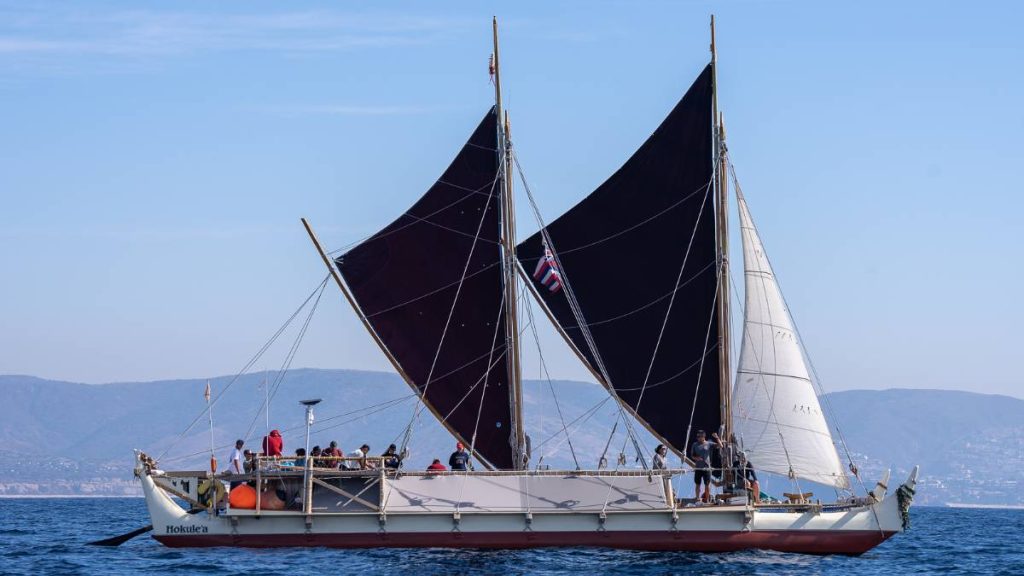Hōkūleʻa makes final stops on California leg of Moananuiākea Voyage

Hōkūleʻa today departed Dana Point and headed to San Diego, the final stop in California and the US continent for the Moananuiākea Voyage.
After San Diego, the canoe will be shipped back to Hawaiʻi where the Polynesian Voyaging Society will focus on training, education and planning until the Moananuiākea Voyage’s circumnavigation of the Pacific continues at a time that is yet to be determined.
During the recent stops at Newport Beach and Dana Point where the canoe arrived on Saturday, Hōkūleʻa received heartwarming greetings by hundreds of people including many from the paddling, surfing, indigenous and Native Hawaiian communities.
The canoe is currently docked at Dana Point’s Ocean Institute where a series of crew presentations, film screenings and dockside canoe tours are being held. Each community has been eager to engage and connect with Hawaiʻi’s voyaging canoe, which last sailed down the US West Coast in 1995.
After the stop in San Diego, where several engagements are scheduled, Hōkūleʻa will return to Hawaiʻi. The Polynesian Voyaging Society announced in August that it was making this major change to the Moananuiākea Voyage sail plan and that Hōkūleʻa would be returning home in late December due to the devastating fires on Maui and the desire to bring Hōkūleʻa home at a time when her home is hurting.
Another contributing factor was the earthʻs unprecedented weather patterns including the current El Nino phenomenon, a period of unusually warm water in the Pacific Ocean, which has global impact. The Polynesian Voyaging Society has been evaluating climate and weather data over the last nine months. The intention was to sail Hōkūleʻa home, but recently released data shows El Nino strengthening even further.
“In keeping with the reasons we decided to bring Hōkūleʻa home, and after lengthy conversations with several sources of expertise including NOAA’s National Weather Service (Central and Eastern Pacific), National Hurricane Center of the Pacific, Central Pacific Hurricane Center, Climate Prediction Center and while looking at the latest ENSO reports and information, we were able to look at the risk of sailing this time of year in the North Pacific under this El Nino forecast. We had no choice but to pay attention and make a decision to ship Hōkūleʻa home based on safety,” said Polynesian Voyaging Society CEO Nainoa Thompson.
“At the time of the August announcement, I thought it would be sailable, but so much has changed so quickly since then. The signs for adverse weather are there, and we need to pay attention and respect. Thatʻs what we do. We watch what nature is telling us and make choices based on it. We keep voyaging on the edge of exploration, but we keep it safe.”
Once Hōkūleʻa returns home, the crew will sail to Lāhainā to bring the canoe close to the voyaging family.
“Lāhainā is a voyaging powerhouse,” and “I believe the family is going to need the canoe and the canoe is going to need the family,” Thompson said in August’s announcement.
While back in Hawaiʻi, the Polynesian Voyaging Society will continue activities focused on its voyaging perpetuation and educational mission including training sails and community outreach until the Polynesian Voyaging Society can determine that the weather is going to be safe enough to circumnavigate the Pacific.
Hōkūleʻa will have sailed 2,800 miles and visited 35 communities from Yakutat, Alaska to San Diego since the Polynesian Voyaging Society held its Alaska Heritage Sail and then the global launch of the four-year circumnavigation of the Pacific in Juneau, Alaska on June 15, 2023. The canoe and her crew sailed through British Columbia, to Washington State, and down the West Coast of Oregon and California, where she is now docked in Dana Point engaging with First Nations communities, Native Hawaiian communities and the general public throughout.
The circumnavigation of the Pacific will cover an estimated 43,000 nautical miles, 36 countries and archipelagoes, nearly 100 indigenous territories and more than 300 ports. Led by the Polynesian Voyaging Society, the Voyage is a global educational campaign that will amplify the vital importance of oceans and indigenous knowledge through port engagements, education and storytelling.





